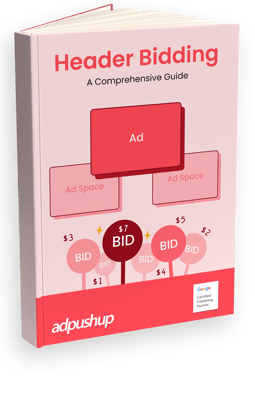Header Bidding Explained: How It Works And Why Publishers Love it?
Header bidding is an advanced programmatic technique that allows publishers to offer their inventory to multiple SSPs and ad exchanges before requesting ad servers from DoubleClick for Publishers (DFP). Publishers can now seamlessly generate bid requests via browser resources by integrating JavaScript (JS) code in the head section of their website. As a result of this filtering, the highest bidder's ad is shown on the user's screen from the publisher's ad server.
With this E-book, we shine a light on why Header Bidding has become the buzzword in the ad tech space.
Here’s what you’ll learn:
- Definition and history of Header Bidding
- Wrapper and Adapter explained
- Client- vs. Server-side Header Bidding
- Steps to prepare and optimize the setup
- Google and Amazon alternatives to Header Bidding
How Header Bidding Transforms Publishers?
The header bidding arrangement has been highly beneficial, with publishers experiencing revenue growth of 20-50%. It has paved the way for an unbiased pre-auction for advertisers, ultimately leading to increased competition, higher CPMs, and soaring growth. Here's a major benefit of Header Bidding explained by Ankit Oberoi, CEO, AdPushup;
“Apart from allowing publishers greater control and improved revenues, header bidding brings much-needed transparency to the ad-bidding ecosystem. In the process, it helps advertisers too, giving them better visibility into the entire ad inventory of the publisher.”
Key Takeaways
- Vital Benefits
a) Publisher: Increases the yield for publishers by 20-50%
b) Advertiser: Allows advertisers to see all the available inventory in a single request
c) Supply-side: Allows publishers to see all the available inventory in a single request. - Efficient and easy to integrate
- Increased conversion rates
- More control over inventory for publishers
Header Bidding Explained
Header Bidding begins as soon as the page begins to load within the browser, with the code connecting to the various supply-side platforms (SSPs) for bids before calling the ad server. Then, a secondary auction occurs between the bids from various partners connected to the ad server.
Though here we've explained how Header Bidding has carved its niche in the ad tech space, our E-book takes a deeper dive into what makes Header Bidding the toast of publishers. Download the E-book to learn more!
.png?width=150&name=image%20(16).png)
